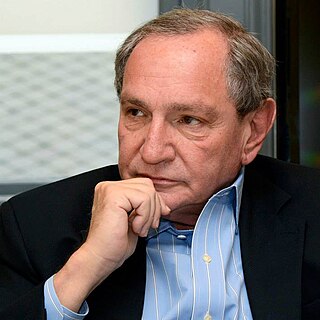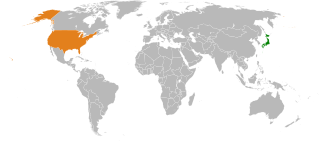
Milton Friedman was an American economist and statistician who received the 1976 Nobel Memorial Prize in Economic Sciences for his research on consumption analysis, monetary history and theory and the complexity of stabilization policy. With George Stigler, Friedman was among the intellectual leaders of the Chicago school of economics, a neoclassical school of economic thought associated with the work of the faculty at the University of Chicago that rejected Keynesianism in favor of monetarism until the mid-1970s, when it turned to new classical macroeconomics heavily based on the concept of rational expectations. Several students, young professors and academics who were recruited or mentored by Friedman at Chicago went on to become leading economists, including Gary Becker, Robert Fogel, and Robert Lucas Jr.
Ruth Shick Montgomery was a journalist with a long and distinguished career as a reporter, correspondent, and syndicated columnist in Washington, DC.

Thomas L. Saaty was a Distinguished University Professor at the University of Pittsburgh, where he taught in the Joseph M. Katz Graduate School of Business. He is the inventor, architect, and primary theoretician of the Analytic Hierarchy Process (AHP), a decision-making framework used for large-scale, multiparty, multi-criteria decision analysis, and of the Analytic Network Process (ANP), its generalization to decisions with dependence and feedback. Later on, he generalized the mathematics of the ANP to the Neural Network Process (NNP) with application to neural firing and synthesis but none of them gain such popularity as AHP.

Nouriel Roubini is a Turkish-born Iranian-American economic consultant, economist, and writer. He is a Professor Emeritus since 2021 at the Stern School of Business of New York University.

George Friedman is a Hungarian-born American futurologist, political scientist, and writer. He is a geopolitical author on international relations. He is the founder and chairman of Geopolitical Futures. Prior to founding Geopolitical Futures, he was chairman of the publishing company Stratfor.

Ian Buruma is a Dutch writer and editor who lives and works in the United States. In 2017, he became editor of The New York Review of Books, but left the position in September 2018.

The Man Who Saw Tomorrow is a 1981 documentary-style movie about the predictions of French astrologer and physician Michel de Notredame (Nostradamus).

Harold Egbert Camping was an American Christian radio broadcaster and evangelist. Beginning in 1958, he served as president of Family Radio, a California-based radio station group that, at its peak, broadcast to more than 150 markets in the United States. In October 2011, he retired from active broadcasting following a stroke, but still maintained a role at Family Radio until his death. Camping is notorious for issuing a succession of failed predictions of dates for the End Times, which temporarily gained him a global following and millions of dollars of donations.

International relations between Japan and the United States began in the late 18th and early 19th century with the diplomatic but force-backed missions of U.S. ship captains James Glynn and Matthew C. Perry to the Tokugawa shogunate. Following the Meiji Restoration, the countries maintained relatively cordial relations. Potential disputes were resolved. Japan acknowledged American control of Hawaii and the Philippines, and the United States reciprocated regarding Korea. Disagreements about Japanese immigration to the U.S. were resolved in 1907. The two were allies against Germany in World War I.
There were people and organizations who predicted that the USSR would dissolve before the eventual dissolution of the USSR in 1991.
Kenneth S. Stern is an American attorney and an author. He is the director of the Bard Center for the Study of Hate, a program of the Human Rights Project at Bard College. From 2014 to 2018 he was the executive director of the Justus & Karin Rosenberg Foundation. From 1989 to 2014 he was the director of antisemitism, hate studies and extremism for the American Jewish Committee. In 2000, Stern was a special advisor to the defense in the David Irving v. Penguin Books and Deborah Lipstadt trial. His 2020 book, The Conflict Over the Conflict: The Israel/Palestine Campus Debate, examines attempts of partisans of each side to censor the other, and the resulting damage to the academy.

Bruce Bueno de Mesquita is a political scientist, professor at New York University, and senior fellow at Stanford University's Hoover Institution.

This article lists Christian religious predictions that failed to come about in the specified time frame, listed by religious group.

The Next 100 Years is a 2009 speculative nonfiction book by George Friedman. In the book, Friedman attempts to predict the major geopolitical events and trends of the 21st century. Friedman also speculates in the book on changes in technology and culture that may take place during this period.

The Coming Collapse of China is a book by Gordon G. Chang, published in 2001, in which he argued that the Chinese Communist Party (CCP) was the root cause of many of China's problems and would cause the country's collapse by 2011. When 2011 was almost over, Chang admitted that his prediction was wrong but said it was off by only a year, asserting in Foreign Policy that the CCP would fall in 2012. Consequently he made the magazine's "10 worst predictions of the year" twice.

The Case for Impeachment is a non-fiction book by American University Distinguished Professor of History Allan Lichtman arguing for the impeachment of Donald Trump. It was published on April 18, 2017, by Dey Street Books, an imprint of HarperCollins. Lichtman predicted to The Washington Post that after ascending to the presidency, Trump would later be impeached from office. He developed this thesis into a set of multiple arguments for Trump's predicted impeachment.
David Meade is the pen name of an American end-times conspiracy theorist and book author who has yet to disclose his real name. Meade, who describes himself as a "Christian numerologist", claims to have attended the University of Louisville, where he "studied astronomy, among other subjects"; because his real name is unknown, The Washington Post reported that the university could not confirm whether he had ever been a student there. He is also a writer, researcher and investigator who has written and self-published at least 13 books. He made appearances and interviews on Coast to Coast AM, The Washington Post, Glenn Beck Program, YouTube with pastor Paul Begley, and the Daily Express. He is best known for making numerous failed predictions, which have passed, regarding the end times, including that a hidden planet named Nibiru would destroy the Earth.

American decline is the idea that the United States of America is diminishing in power on a relative basis geopolitically, militarily, financially, economically, and technologically. It can also refer to absolute declines demographically, socially, morally, spiritually, culturally, in matters of healthcare, and/or on environmental issues. There has been debate over the extent of the decline, and whether it is relative or absolute.

The Coming Conflict With China is a 1997 book by Richard Bernstein and Ross H. Munro. The book argued that conflict between the United States and the People's Republic of China would dominate the early decades of the 21st century and advocated various steps to counter what the authors saw as the Chinese threat to the US.
















